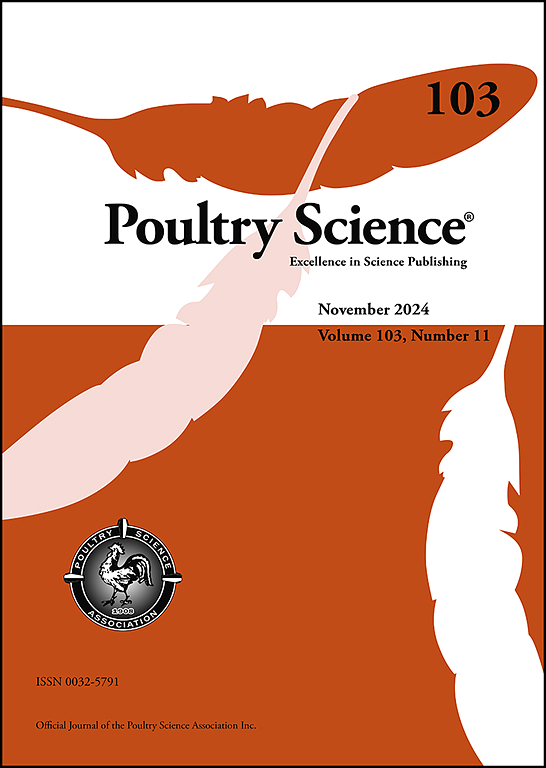Vaccination with formulations targeting Eimeria maxima and Clostridium perfringens conferred comprehensive protection using a dual-infection challenge model of necrotic enteritis
IF 4.2
1区 农林科学
Q1 AGRICULTURE, DAIRY & ANIMAL SCIENCE
引用次数: 0
Abstract
With increasing regulations restricting antibiotic use in animal feed, the need for alternative strategies to prevent and manage necrotic enteritis (NE) has become imperative. As a result, developing effective vaccines has emerged as a top priority for broiler chicken health management. Coccidial infections are a well-established predisposing factor for NE, underscoring the importance of controlling coccidiosis to help mitigate NE outbreaks. This research aimed to investigate the protective efficacy of vaccine preparations containing Eimeria maxima elongation factor-1α and a multicomponent antigen cocktail of Clostridium perfringens, including a single collagen adhesion protein (CpCna) and two chimeric proteins: CpNA (NetB-Alpha-toxin) and CpFZ (Fructose-1,6-bisphosphate aldolase-Zinc metalloprotease). Two vaccine preparations—recombinant subunit vaccines and DNA vaccines—were developed to assess their immunoprotective effects, determined by relative body weight gain rate, lesion scores, survival rates, and antigen-specific IgY levels using a dual-infection NE challenge model involving E. maxima and C. perfringens. Broilers were administered two subcutaneous immunizations with either adjuvanted proteins or eukaryotic expression plasmids on Days 7 and 17. Chickens vaccinated with the five antigens exhibited significantly higher serum antigen-specific IgY levels, improved weight gains, zero mortality, and reduced lesion scores following the lethal dual-infection challenge. These results indicated that vaccine preparations targeting both C. perfringens and E. maxima represent a promising approach for controlling and preventing coccidiosis-induced NE in chickens.
接种以最大艾美耳球虫和产气荚膜梭菌为目标的疫苗,在坏死性肠炎的双重感染攻击模型中具有全面的保护作用。
随着越来越多的法规限制在动物饲料中使用抗生素,需要采取替代策略来预防和管理坏死性肠炎(NE)已成为当务之急。因此,开发有效的疫苗已成为肉鸡健康管理的重中之重。球虫感染是一种公认的易患东北血吸虫病的因素,强调了控制球虫病有助于减轻东北血吸虫病暴发的重要性。本研究旨在研究含最大艾美耳球虫伸长因子-1α和产气荚膜梭菌多组分抗原混合物(包括单一胶原粘附蛋白CpCna)和两个嵌合蛋白CpNA (netb - α -毒素)和CpFZ(果糖-1,6-二磷酸醛缩酶-锌金属蛋白酶)的疫苗制剂的保护效果。两种疫苗制剂——重组亚单位疫苗和DNA疫苗——被开发出来评估它们的免疫保护作用,通过使用涉及最大大肠杆菌和产气荚膜荚膜梭菌的双重感染NE攻击模型,通过相对体重增加率、病变评分、存活率和抗原特异性IgY水平来确定。在第7天和第17天分别用佐剂蛋白或真核表达质粒皮下免疫两次。接种五种抗原的鸡在致死性双重感染攻击后表现出明显更高的血清抗原特异性IgY水平、改善体重增加、零死亡率和降低病变评分。这些结果表明,疫苗制剂针对c . perfringens和大肠maxima代表一种很有前途的方法来控制和预防coccidiosis-induced NE在鸡。
本文章由计算机程序翻译,如有差异,请以英文原文为准。
求助全文
约1分钟内获得全文
求助全文
来源期刊

Poultry Science
农林科学-奶制品与动物科学
CiteScore
7.60
自引率
15.90%
发文量
0
审稿时长
94 days
期刊介绍:
First self-published in 1921, Poultry Science is an internationally renowned monthly journal, known as the authoritative source for a broad range of poultry information and high-caliber research. The journal plays a pivotal role in the dissemination of preeminent poultry-related knowledge across all disciplines. As of January 2020, Poultry Science will become an Open Access journal with no subscription charges, meaning authors who publish here can make their research immediately, permanently, and freely accessible worldwide while retaining copyright to their work. Papers submitted for publication after October 1, 2019 will be published as Open Access papers.
An international journal, Poultry Science publishes original papers, research notes, symposium papers, and reviews of basic science as applied to poultry. This authoritative source of poultry information is consistently ranked by ISI Impact Factor as one of the top 10 agriculture, dairy and animal science journals to deliver high-caliber research. Currently it is the highest-ranked (by Impact Factor and Eigenfactor) journal dedicated to publishing poultry research. Subject areas include breeding, genetics, education, production, management, environment, health, behavior, welfare, immunology, molecular biology, metabolism, nutrition, physiology, reproduction, processing, and products.
 求助内容:
求助内容: 应助结果提醒方式:
应助结果提醒方式:


